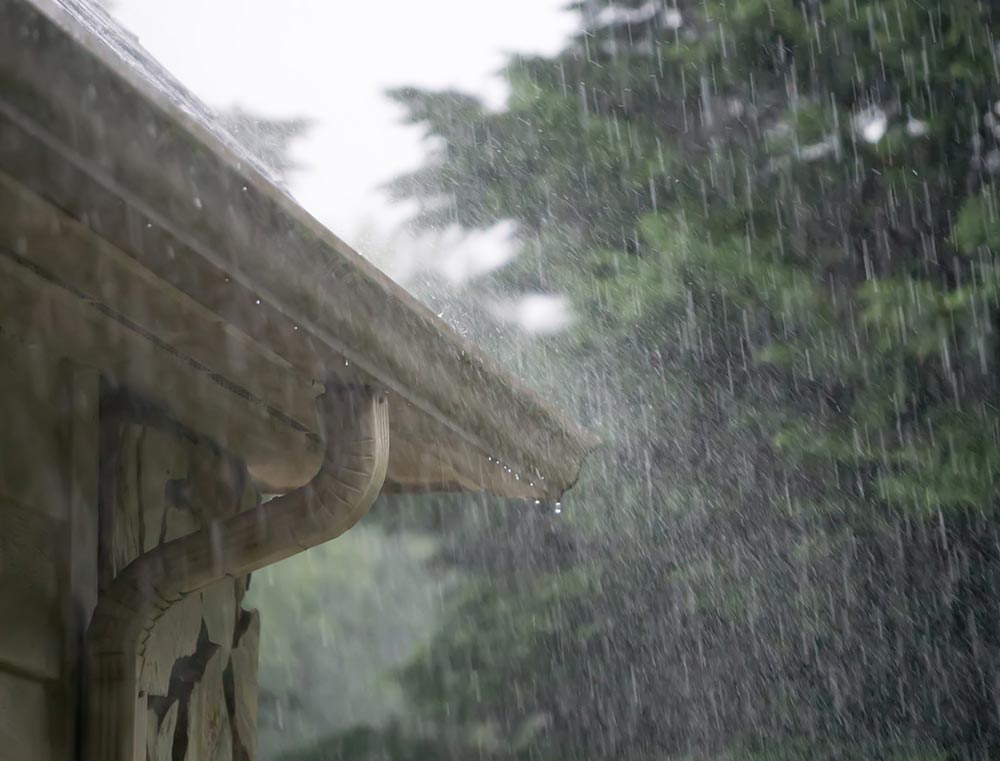Spring Preparation & Maintenance
Contents
A Yearly Checklist for Your Home
Spring is the perfect time to tackle the home projects on your to-do list. Your home needs regular care in order to maintain its value. After a harsh winter, some areas may need extra attention. The milder spring weather can create ideal conditions for all kinds of home maintenance.

01. Exterior Preparation
The exterior of your home takes the brunt of harsh weather and all that comes with it. Repair winter damage as soon as you’re able. When the warmer weather comes, you should begin inspecting your home for any exterior work that may need to be done.
Roof
Inspect your roofing materials.
Inspecting your roof before winter hits is essential for preventing damage to your home, and inspecting your roof after the season has passed is equally important. Winter weather can wreak havoc on your home. You don’t want a lovely spring rain to turn into a roof leak. Inspect your roof for damage by looking for peeling, cracking, and sagging materials. When shingles shed granules excessively, this is a sign of damage that can lead to curling or peeling. Missing granules also make your roof more susceptible to damage from the sun, which could be a problem in the upcoming summer months.
Take a close look at flashing.
Damage and leaks often occur on the areas of your roof where there is flashing. You’ll want to be sure that all flashing around chimneys, vents, and any other seams is unharmed and firmly attached. The safest way to inspect your roof is from a ladder without climbing onto the roof, which is what we recommend. If you’re unsure whether what you’re seeing is damage, it’s best to call a professional to make an inspection and give an estimate.
Manage growth around your home.
Trees and shrubs grow in the spring and summer, so it’s important to manage them around your home before they get out of hand. Trees can drip moisture onto your roof and drop debris into your gutters, and overhanging limbs could fall during a storm and cause damage. Trim trees back in the spring, leaving five to seven feet of clearance between the branches and the edge of your roof.
Moss and mildew are additional issues to monitor in the spring. Moss traps moisture on the roof, damaging roofing materials and shortening the roof’s lifespan. Mildew isn’t necessarily harmful to the roof itself, but it can leave stains that lower your home’s curb appeal.
Gutters and Downspouts
Your gutters are critical for keeping water away from your home. Over the winter, they may have taken a beating from snow and ice buildup. The pattern of freezing and thawing can be hard on your gutters, causing them to stretch and break. In spring, it’s a good idea to thoroughly inspect your gutters and downspouts for winter damage. A broken or clogged gutter can lead to a huge problem if it’s not fixed before a heavy rain.
Clean gutters of any debris that may have found its way inside. You can clean gutters by simply pulling debris out using a ladder and gloves. Your downspouts should send water 5 feet from foundation walls. If you notice water isn’t flowing properly through the downspouts, they may be clogged with debris as well. You can use a plumber’s snake to break up debris in the downspout.
Siding and Trim
If you have vinyl or wood siding, inspect it in the spring and evaluate its overall condition. Look for obvious damage such as cracks, loose or missing pieces, or rot. Wood siding can rot if mold or mildew traps moisture for too long. Wash away any mold or mildew so you can clearly see any damage that may exist. Correct any damage as soon as possible to make sure your home stays protected from the elements.
Water stains on your siding usually indicate that your gutters aren’t functioning properly. You may notice efflorescence on brick siding, which is a whitish, powdery residue that is left when water evaporates. While it’s usually just an aesthetic issue, it can also indicate that you have a problem with excess moisture. If you notice this on your siding or trim, contact a professional to have it examined.
Property Management
Landscaping
Spring is a great time to manage all the parts of your property that are often overlooked. Yard work is a staple for the spring season. Take advantage of nice weather and tackle your landscaping. Landscaping keeps your home looking great on the outside, but it’s also important for managing soil erosion and water drainage. The ground should slope away from the house to keep moisture away from your foundation and prevent water damage. Trim shrubs and foliage away from your home’s siding. While you’re trimming, also check your foundation vents for damage. The vents need room for airflow, so make sure nothing is blocking them.
Sump Pump
When spring rains come, you want your home to be prepared to handle the longest torrential downpour. Your sump pump is an important defense against flooding. Check to make sure your pump is functioning properly by pouring water into the pit. If the pump activates and begins to push water out, it is functioning. According to InterNACHI, your pump should also be inspected by a professional each year.
Chimney
It’s a good idea to give your chimney an inspection and cleaning during the spring months. A thorough cleaning should be done to look for cracks or crevices. When cracks exist, you run the risk of attracting nesting birds or insects in spring and summer. Chimney cleaning and inspection should always be conducted by a professional.

02. Interior Maintenance
The interior elements of your home need attention, too. In addition to spring cleaning, schedule some time to improve your systems in preparation for summer.
HVAC
Your home’s HVAC system has been working hard all winter, and it will work hard all summer. If your system breaks down, it will be more expensive to fix in the winter or summer months. Inspecting for problems is best done in the milder seasons, when it’s easier to correct them. Spring is a good time to have your ducts fully cleaned. This can improve the air quality in your home and help to ensure proper airflow. Checking the refrigerant and filters during this time can also help keep your air cleaner and your energy bills to a minimum.
Ceilings and Walls
Once you’ve looked for signs of water damage on the outside of your home, check on the inside. If your roof leaks, your walls and ceilings will be the main places that water damage will show. Look for discoloration, bumps or bubbles, and dampness. Catching water damage and leaks early is key to keeping your home free of mold and mildew. If winter weather was already hard on your roof, you don’t want a mold problem added to it.
Batteries
While there’s no specific reason that spring is a good time to check smoke and carbon monoxide batteries, we recommend it in order to get you into a routine of checking them. They should be tested at least once a year.
Attic
Like your ceiling and walls, your attic should be inspected for water damage. Additionally, check your attic for signs of pests, since nesting birds, insects, and other creatures may have found their way inside. Look for nests, droppings, or damage to your insulation. If you notice signs of pests, call a professional to remove them and prevent them from entering in the future.
Windows and Doors
Clean your windows and doors to let all of the fresh spring light in. Pleasant weather provides a great opportunity to take your windows out and fully clean them while letting the fresh air waft through your home. While cleaning, take time to inspect the seals around the windows. You want them well insulated to prepare for summer heat. Look for caulking that may be degraded. Spring is also a great time to have your windows replaced if they are old and drafty.

03. Severe Spring Weather Home Hazards
Spring is known for its storms. Severe weather can come unexpectedly, and your home should be prepared to handle it with minimal damage. While you can’t predict what weather will come, you can be prepared.
Thunderstorms and Lightning
Thunderstorms and lightning are common, but they can be fierce. Lightning can damage your home by fire, electrical surge, and shock wave. Fires often begin on the roof. If you smell fire, evacuate to a safe location and call emergency responders to handle the fire. To protect from power surges, invest in a surge protector. This will help prevent damage to your appliances and electronics.
Hailstorms
When a hailstorm hits, you will want to be sure that your roof is in good condition. Keeping your roof maintained can make a huge difference when a storm hits. Steep-sloped roofs typically suffer less damage from hail than flat or low-sloped roofs. If your home has skylights, be sure they have a high-impact rating and are properly sealed. During a hailstorm, protect your family by closing blinds and drapes and staying away from windows.
Flash Floods
If you live in an area prone to flash flooding, make preparations before flood season arrives. Your sump pump should be installed and functioning properly before spring. This is one of your home’s top defenses against flooding. You can also invest in coatings and sealants that make your foundation less susceptible to soaking up flood water. A functioning gutter system and properly landscaped lawn can also help with keeping water away from your home.
High Winds and Tornadoes
Heavy winds and tornadoes can be some of the scariest kinds of severe weather. Wind can do a lot of damage to your home. Keep it safer by trimming limbs away from your home at the beginning of the season. In addition, if you know a storm is coming, put away any outdoor furniture that could be lifted into the air by high winds. Early in the spring, have your roof inspected to ensure materials are properly installed and sealed to reduce the risk of wind damage.

04. Home Improvement Projects
Spring is an ideal time to tackle the large home improvement projects you’ve been waiting to do.
Repair or replace your roof.
Roof replacements and repairs are great investments for your home and timely for the spring season. A healthy roof can add value to your home, decrease energy bills, and increase durability. After a long winter, your roof may need repairs. Let a professional help you figure out if it’s time for your roof to be replaced.
If you decide to replace your roof, you’ll want to do some research to determine what roofing material is best for you. Asphalt shingles are affordable, which makes them popular. They also provide adequate protection and can be found in many colors and styles to suit your home. Metal roofing is another popular option due to its durability and longevity. Metal roofs are resistant to fire, moisture, and severe weather of all kinds. Slate is the longest lasting roofing material, but it’s also the heaviest, which makes it costly. A roofing professional can help you decide which would be best for your home.
Fix or upgrade your siding.
Spring is an important time to consider the need for siding repairs or replacement. Summer heat and intense sunshine can quickly wear down your siding, and so can spring storms. Replacing or repairing your siding as needed in the spring is important to keep your home free from damage.
You have a number of options for siding materials.
- Vinyl, which can come in just about every color and texture imaginable, is among the most popular. It’s lightweight and can be installed over existing materials.
- Wood siding requires more maintenance than other siding, but it’s lovely and durable if you’re willing to put in the work.
- Fiber cement siding won’t rot, and it’s resistant to problems such as fire and pests, which makes it a good choice for many different climates. Fiber cement is heavy, however, which makes installation more difficult and expensive.
- Metal siding requires very little upkeep. Because it’s moisture resistant, it helps to keep the structure of your home secure while standing up to harsh weather. Metal is very customizable, so it’s available in many colors and styles.
Get a new HVAC system.
You want your HVAC system running at top performance at all times, but if you need it replaced, spring is a good time to do it. Replacing your HVAC system could make your home much more energy efficient.
There are several elements to consider when choosing the right HVAC system. There are single-stage or multi-stage systems. Single-stage units are popular in areas with extreme heat or cold, but they can use a lot of energy because they always work at full capacity. Multi-stage systems can use substantially less energy because they can operate at reduced capacity when less heating or cooling power is needed.
Zoned systems allow you to focus heating or cooling on specific parts of your home. This can save energy by using it only where needed. Humidity control can also help save energy, since maintaining proper levels makes a home feel more comfortable. You can have humidifiers and dehumidifiers added to your system to directly control the humidity levels in your home.
Heating units typically operate with a furnace or boiler. Furnaces will use gas or propane, while boilers use gas or oil for fuel. You will want to look for a high fuel efficiency rating in the 80s or 90s. Cooling systems are judged on a Seasonal Energy Efficiency Rating (SEER). Look for a SEER rating above 13 to get the most energy-efficient and cost-effective system.
Spruce up your landscaping.
Spring is a time of renewal in nature, and it can be a time for renewing your home, as well! Giving your home’s landscaping a makeover can change its entire exterior appearance. Landscaping is a visual improvement, and if done right it also helps ensure proper water drainage.
Sloping your landscaping so that it drains water away from your home is one of the most effective ways to avoid flooding and water damage to your foundation. Trim foliage and shrubs away from your home so you can see where damage might have occurred and water may be pooling. Add mulch to the beds around the home, sloping down and away from the house, to benefit your plants as well as your foundation. While making landscape updates, consider other steps like updating your patio and painting your home! Improving your home’s aesthetics can do more than make you feel better; it can also increase your home’s value.